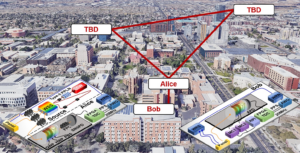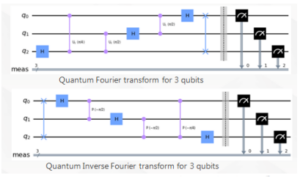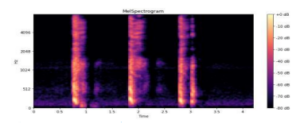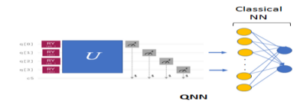Descriptions of Sample REU Projects:
Sample Project 1: Signal Analysis and Feature Extraction using the Quantum Fourier Transform
Mentors: TBD
Goal: Students will learn to program the Quantum Fourier Transform (QFT) and use it for signal analysis and QML feature extraction. Research will include QFT Qiskit simulations and quantum noise studies.
Comparisons with classical Fast Fourier Transform (FFT) analysis will be performed.
Description and Experimental Part: The training and REU research on quantum Fourier transforms focuses on signal analysis and frequency domain feature extraction for QML applications. Quantum circuits will be designed for a QFT and an inverse QFT (IQFT) (Fig. 1) and their effectiveness will be tested in terms of resolving frequency components of real and synthetic signals. In addition, simulations will be run for signal analysis and reconstruction for possible use in compression applications. Moreover, the QFT will be used to extract features for signal classification applications as a preprocessor to a QML algorithm. Through this project REU students will learn how to design and assess quantum circuits and simulations. REU students will experiment with the size of the QFT, the number of qubits used and the effects of quantum noise in their QFT simulations. Precision effects will be explored by varying the number of qubits. Comparison of QFT with classical FFT in signal analysis will be performed. Our team has an award winning study on evaluating these QFT/FFT comparisons in a DSP class. Also because this project has applications in data compression/transmission, some students can experiment with quantum communication networks transceiver simulations in the ASU quantum networking lab.
Students will use the QFT to extract features for QML-based audio classification (discussed later). Students will document the effect of the number of qubits as well as the effect of quantum noise. Simple quantum circuits for the QFT and IQFT are shown in Figure 1. Signal reconstruction will be implemented using speech data from the TIMIT and Google databases. Students can also experiment by recording voice or audio and evaluating these quantum signal reconstruction simulations. The QFT experiment is also important in understanding the use of frequency features for QML-based audio recognition (see Project 2).
Theoretical Component: Understand the QFT circuit development theory and study QFT noise models.
Outcome: The students will study signal analysis-synthesis using QFTs. Student research will evaluate the quality of the spectral representation by varying various parameters in their quantum simulations including size of the QFT, number of qubits, and types of quantum noise models embedded in the simulation. Students will produce unique and potentially publishable comparisons against FFT based analysis. The project will also study the use of quantum spectral features in QML audio recognition.
Sample Project 2: QML for Classifying Audio for Health Diagnostics
Mentors: TBD
Goal: Students will learn to use signal and ML tools to classify audio data. Pre-processing algorithms will be used to extract spectral features for audio recognition. Students will compute spectrograms using QFTs and then use QNNs to classify different sounds. The faculty team has several ML python tools for audio classification. The research task will be to develop a unique QML architecture to recognize audio.
Description and Experimental Part: Students will study the use of quantum neural networks in audio classification. More specifically, a deep learning model for detecting breathing pathologies and coughing signatures for various conditions, including COVID-19, will be examined. Benefits of using QC include secure and fast computation as well as the ability to deal with vast databases. The project will examine the design of a hybrid Quantum-Convolutional Neural Network (Q-CNN) architecture and provide classification accuracy results. COVID-19 cough audio spectrogram features such as those in Fig. 2 can be extracted from public databases and classification with the Q-CNN can be evaluated in terms of a confusion matrix. With appropriate segmentation and feature extraction, it can be shown that COVID cough detection can reach nearly 80%. A quantum circuit for audio cough detection is shown in Fig. 3. Students will design and study their own QNN simulations and evaluate QNN classification accuracy. Students can also study using the QFT and adapting its resolution to generate features for the QNN.
Theoretical Component: Understand Q-CNN hyperparameter tuning on training and detection accuracy.
Outcomes: Students will learn about audio spectrogram feature extraction and QML model training and evaluation. They will focus specifically on designing unique QNN algorithms. Because the project will involve both QC and ML REU students will explore both quantum precision and ML algorithm accuracy. Students will adjust the QNN parameters and explore data segmentation strategies. With novel QNN architecture design and research with unique anonymous healthcare data, comparative quantum versus classical results with appropriate statistical analysis will provide REU opportunities for publication.
Sample Project 3: Optimizing Entanglement Distribution in Quantum Networks
Mentor: Dr. Joseph Lukens
Quantum networking is the next phase of quantum information science research, providing the catalyst for unconditionally secure communications, distributed quantum computing, and quantum-enhanced sensing. By enabling the transmission of quantum information and the establishment of entanglement, future quantum networks—and their culmination, the quantum internet—will connect users throughout the world with quantum resources, efficiently and on demand. Yet integrating quantum signals and protocols into the existing fiber-optic infrastructure presents a variety of both fundamental and practical challenges. In this project, students will study the distribution of quantum entanglement in flex-grid optical networking, a state-of-the-art paradigm in classical light wave communications for managing resources in wavelength-division multiplexing. Spanning theory, simulation, and experiment, this project will offer students a comprehensive introduction to quantum networking and fiber-optic communications, including proof-of-concept demonstrations in a deployed quantum network on the ASU campus. The research performed will provide valuable learning experiences while also advancing the field of practical and scalable quantum.

Figure 4. ASU metro-area quantum network testbed currently under construction. Satellite imagery from Google Earth.
Additional Projects will be listed soon
The program is sponsored by NSF CISE REU Project Award 2349567





